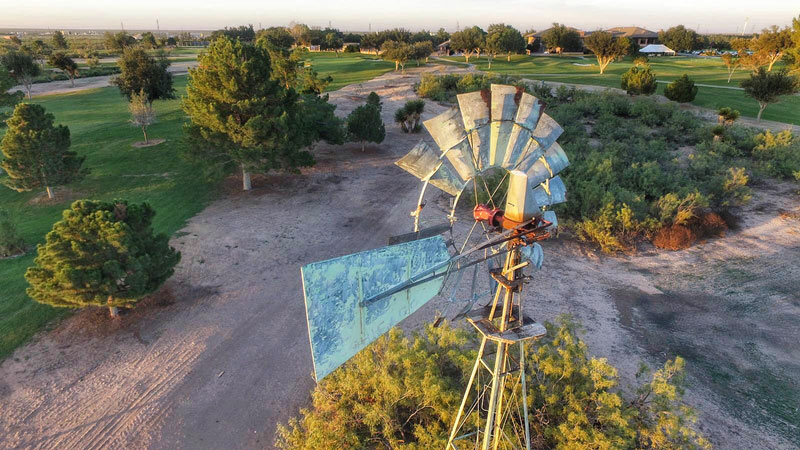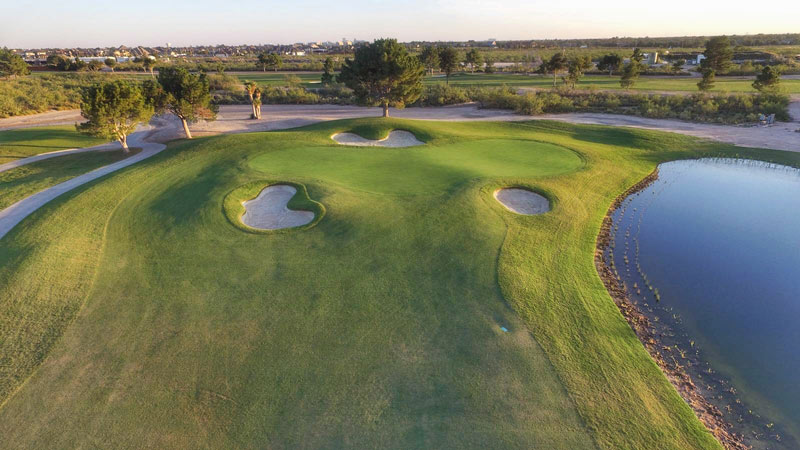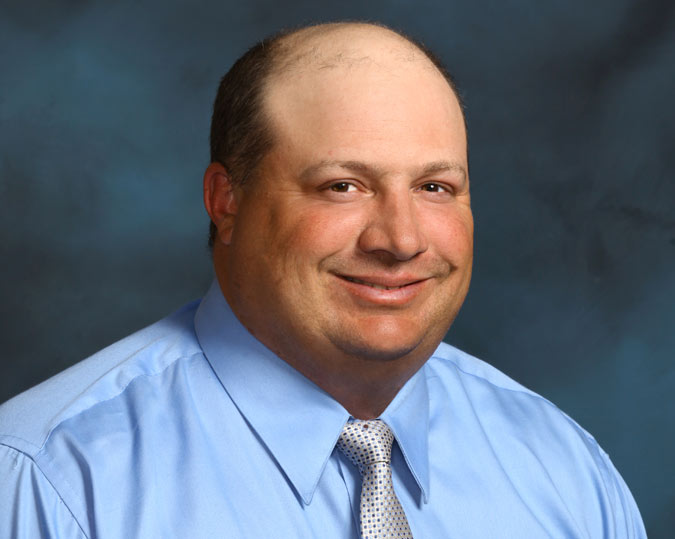
Texas treasure: Founded in 1927, Midland CC counts two former U.S. presidents — George H.W. Bush and George W. Bush — among those who’ve held membership. The Bushes have returned on occasion to play the club’s 18-hole crowning jewel. Photos courtesy of Midland Country Club
How much do members of your typical equity club actually know about what they want from a golf course renovation? Perhaps not as much as would be ideal. Nevertheless, the refurbishment process that concluded this past November at Midland (Texas) Country Club, authored by Weibring-Wolfard Golf Design, illustrates the power of showing those members what they might want and expect as opposed to telling them.
“Most clubs don’t know at the outset what they truly need or want — they might have some bullet points they’ve settled on,” says Steve Wolfard, a partner in Frisco, Texas-based Weibring-Wolfard. “At Midland, they knew they needed to rebuild and regrass the greens. They knew the greens had gone beyond the acceptable life span. But we needed to show them our vision for the golf course.”
The renovation of Midland’s practice facility and 18-hole course was the first for which Weibring and Wolfard’s master plan document included a before-and-after presentation. “On one page, we had the hole as it existed then, and when you turned the page, there was the completed golf hole in colored, fully rendered form,” Wolfard says. “That made a big impression.”
The story of just how that persuasive proposal traveled from concept to completion is a lesson for any golf course considering following a similar path to the one traveled by Midland CC.
Irrigation intervention
The water situation at Midland is substandard, a factor that influenced nearly every discussion leading up to groundbreaking. It was so bad, in fact, that superintendent Thomas “Fore” Brown, CGCS, had, out of necessity, backed himself into a series of corners throughout his 15-year tenure at the club. When Midland began seriously entertaining the idea of renovating its golf course in 2013, all design solutions were aimed at also providing maintenance solutions.
“The deck was stacked against the folks at Midland in so many ways,” says Wolfard. Along with poor-quality water features and extremely salty groundwater (3,500 parts per million at best; more than 5,000 at worst), “There was no water storage to speak of, yet here was a golf course superintendent who was maintaining almost 200 acres of turf,” Wolfard says. (Midland has been operating an on-site desalination plant for 30 years. The unit can produce some 100,000 gallons per day; Midland requires some 800,000 a day from May through September. All other courses in the region have gone the desalination route as well.)
“On the old greens, which were push-ups, we were limited to using only ultra-pure water, because they did not drain internally,” Brown explains. “Because the water didn’t drain well, the salts accumulated in the soil and simply did not flush out. If we weren’t careful, it would get to the point where it would be difficult to grow any grass at all.”
All of that served to fatten the master plan document devised by Weibring-Wolfard, a 19-year-old collaboration between Wolfard, a former Nicklaus Design hand, and touring pro D.A. Weibring, whose Plano, Texas-based Golf Resources Group has been repositioning, redesigning and redeveloping golf properties since 1987.
Outside of the boardroom, what Weibring and Wolfard encountered at Midland was a 1950s-era Ralph Plummer design that had been touched several times throughout the years, and not always for the better. And while members were well aware of the water issues that had plagued various maintenance efforts, in terms of design, they had little idea what they wanted the renovation to encompass.
Weibring and Wolfard had their own vision from the start: a new set of greens built to USGA specifications (which would allow for irrigation with Midland’s untreated well water); fewer but larger, more deliberately placed bunkers; a dramatically reduced turf footprint that would entail regrassing with hybrid bermudagrass; water features that would contribute strategy and vastly increased water storage capacity; and a shift from the course’s more tree-lined feel to more of a desert feel, achieved without abandoning the club’s parkland aspirations.
“During the master plan process, we suggested the club move toward a tree-clustering approach, and there were a few worried looks,” says Weibring, a 10-time winner on the PGA and Champions tours. “About 50 years ago, some tree salesman must have made a killing out here, because these Siberian elms were everywhere on the golf course.”
Before-and-after displays are helpful, but a golf course renovation still requires the higher art of persuasion — followed by a leap of faith from the client. Weibring-Wolfard’s master plan made a compelling case, but nature also happened to intervene on their behalf: The winter prior to their proposal, an ice storm had taken out about 200 trees on the course. The firm suggested taking care of a few more of them that were at the end of their life spans.
“I told them, ‘Don’t worry — we’re not going to lollipop your golf course. These groupings will have strategy and create the framing you need for a fun and aesthetic golf course,’” Weibring says. To the design team’s amazement, there wasn’t too much outcry. “I think they had already started to see that there were real vistas out there — and that they kind of liked them,” Weibring says.
A practice swing
Their case made, Weibring and Wolfard were ready to break ground, right? Well, not exactly. The membership at Midland still needed more “showing,” and thus a “phase one” of the project that would focus on the practice area was suggested.
“We had to knock that out of the park in order to give the membership the confidence to do phase two, the 18-hole renovation,” says Wolfard. The design duo proposed taking the existing range — a big, brown, flat, featureless expanse — and transforming it into a modern practice facility, with a short course that members could play while the big course was under construction, and that wouldn’t add to the club’s already outsized acreage of maintained turf.
So, how’d that go over with members? “They loved it,” Wolfard says. “It was also important that phase one met both the proposed budget and completion schedule, which we did.”
Dubbed “The Judy” in honor of longtime Midland member, LPGA legend and World Golf Hall of Famer Judy Rankin, the new short course did indeed unleash the club’s redevelopment mojo. The Judy opened in fall 2015, and the 18-hole course shut down in November. Phase two work got underway that month, with Lincoln, Neb.-based Landscapes Unlimited handling construction duties.
A desert, drones and other details
Midland’s membership had expressed a desire for a “restoration” of the original Ralph Plummer design, which Wolfard says the designers strived to deliver. “We did have a copy of the original hole layouts, which proved really valuable,” Wolfard says. “We adjusted the greens and surrounds back to a more traditional, classic design that would have been advocated by Mr. Plummer. In fact, the nine-hole short course was a part of the original proposed footprint, but had never been constructed.”

Renovations to Midland CC touched greens, tees, bunkers and fairways. The work was authored by Weibring-Wolfard Golf Design, with construction by Landscapes Unlimited.
According to Wolfard, Midland’s members didn’t fully appreciate the fact that they live — and play their golf — in a desert. “The members seemed to think they wanted a tree-lined club like you might find in Houston,” says the architect, noting that Midland is located on the edge of the Chihuahuan Desert. “The club had never really tried to work with these surroundings.” An example? “The overspray here had created a jungle beside each hole,” Wolfard says. “It looked horrible, and you couldn’t play from it. Basically, it was nothing more than a perfect rattlesnake haven beside each hole.”
Weibring-Wolfard perimeter-irrigated the golf course to eliminate the “gunch” by each hole, and took the native, outlying areas and made them more serpentine through the holes, just as one would out in the desert. “We said, ‘Let’s make native an asset — a complement to the golf course design instead of an overgrown mixture of mesquite, common bermuda and other garbage,’” Weibring says.
The designers and Landscapes Unlimited used the breadth of Midland’s existing hole corridors to allow native areas to encroach and recede, creating the illusion of movement on even the straightest of golf holes.
And here’s where the architects, with the assistance of Landscapes Unlimited, were able to put any lingering apprehension among the membership to rest. From the outset of construction, Landscapes Unlimited project superintendent Forest King and his crews supplied members with drone-enabled video updates of the project, allowing them to view what was happening out on the golf course — and it was a hit. The exercise also left an impression on Landscapes Unlimited president Kurt Huseman.
“From the standpoint of renovation, generally speaking you’re never going to get any equity club membership to provide 100 percent approval on these projects in advance,” Huseman says. “Everyone’s a backer when it’s finished, but not upfront and not in the early stages — even if you ultimately gain majority approval. These drone videos allowed us to build a better, more full consensus at Midland. Most folks who belong to these clubs don’t know anything about the evolution of a course renovation from concept to grow-in. This helped them get excited, follow the progress, and really see what’s going on.”
“We did this project on a zero-based budget,” adds Weibring. “There was no room for adjustment. But once the membership saw the drone footage, they were so excited by what they saw, they wanted to do a few more things.”
For Huseman, the slower-paced progression of such projects makes them well-suited to drone use. “Golf construction is great because it doesn’t get finished all at one time,” Huseman says. “The first few holes get grassed and you can really see the progress, see the improvements. I went from not even thinking of using drones in our business to recognizing them as a significant tool in our future.”
A flexible face-lift
Midland’s 18-hole course reopened in October 2016, meaning both phases of the renovation were wrapped up in just 18 months. And while the revamped layout quickly became the apple of the membership’s eye, not every part of its transformation came easily for the renovation team.
Ten years earlier, Midland’s membership had invested in a new irrigation system — something the club hadn’t been so eager to replace. “It was a real puzzle in terms of retrofitting it to our new design,” says Wolfard of that irrigation system, noting that when the designers first showed up on site, “It looked like a bowling alley out there.”
“We didn’t have the money lined up for a new irrigation system, and we didn’t have the money to rip up every square foot of these fairways and reshape them either. We couldn’t just re-grade and put in 200 catch basins. It was a real challenge,” Wolfard says. “The margins for surface drainage were so tight. They had to check and recheck to make sure the water would go somewhere. We really leaned on Landscapes there too.” Wolfard credits Landscapes Unlimited and Brown with doing an excellent job of holding things together and working with irrigation consultant Larry Rogers.
Fairway bunkering also assumed outsized importance on a canvas this big. “The old bunkers looked bad and were not functioning,” says Weibring. “Most of them were raised above the ground a couple feet. They were really perched. When we started getting rid of them, we expected to find 6 to 12 inches of sand — we found 4 feet of sand in some places.”
Weibring-Wolfard resolved to replace clusters of those older bunkers with single large, strategically placed bunkers, with the understanding that such a departure (some of the new bunkers occupy 60,000 square feet) would change the way Brown looks after the golf course.
“We’re taking care of 20 percent less turf, but the time we would have spent there is now devoted to other things,” Brown says. “The bunkers are a good example of what I mean. We have fewer bunkers to maintain than we did before. While there is less overall square footage, there is more detail work to be done on these new bunkers. But they are far more impactful in terms of playability, risk/reward. They’re in just the right spots.”

Family ties: Superintendent Thomas “Fore” Brown, CGCS, has overseen Midland Country Club’s Ralph Plummer-designed course for 15 years, a role his father filled from 1986 to 1995.
“Communication between the club, designer, contractor and the superintendent has to be the central core of the renovation process,” says Wolfard. “The superintendent is really the club’s representative on the ground, in so many ways.” In Wolfard’s view, it’s paramount that the superintendent be engaged in the process through communication and education, and make all the decisions necessary to keep the scale and intent of the project in line with both the club’s expectations and the realities of day-to-day maintenance. “Then, it’s the designer and contractor’s job to exceed those expectations,” Wolfard says. “Hopefully we did that at Midland.”
The more things change
When Brown arrived on the job at Midland 15 years ago, he already knew the property backward and forward. His father, Tom, had been the superintendent from 1986 to 1995, before finishing his career as a competitions agronomist with the PGA Tour. And while much about Midland — which has hosted several Web.com events, most recently in 2015 — has evolved over the years, especially as of late, some things never change. Water, you see, is still an issue. Now, however, a few solutions exist.
“Having modern greens has allowed us to manage our issues with water quality and cultural practices,” Brown says. “We just have so many more options now. We can flush out the root zones much easier, which helps us reduce our demand for desalinized water.” And thanks to greater water storage capacity, the course can stock more water and improve it by mixing in desalinized water to dilute overall salinity.
For Brown, a 21-year GCSAA member, the Midland renovation itself wasn’t necessarily more work than he’d anticipated, but the three years of 80- to 90-hour weeks it demanded were challenging for his family. But, he says, it was worth it. “The course just looks so much more clean from my perspective, and way more impactful from the golfer’s perspective,” Brown says. “It’s hard to describe, but you look at it now and you just say, ‘Wow.’”
Hal Phillips is the managing director of Mandarin Media. He has been writing about golf and golf course management for 25 years, and is a frequent contributor to GCM.